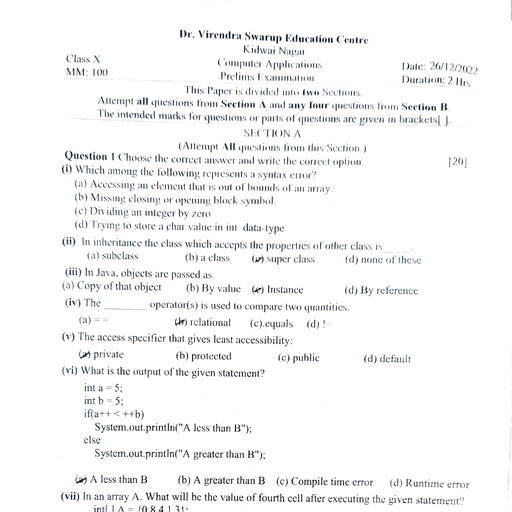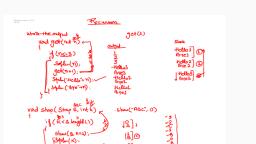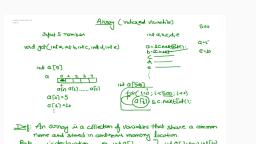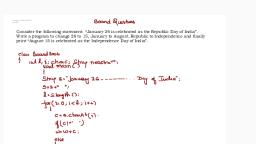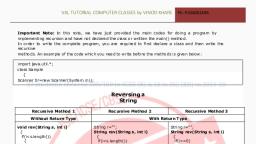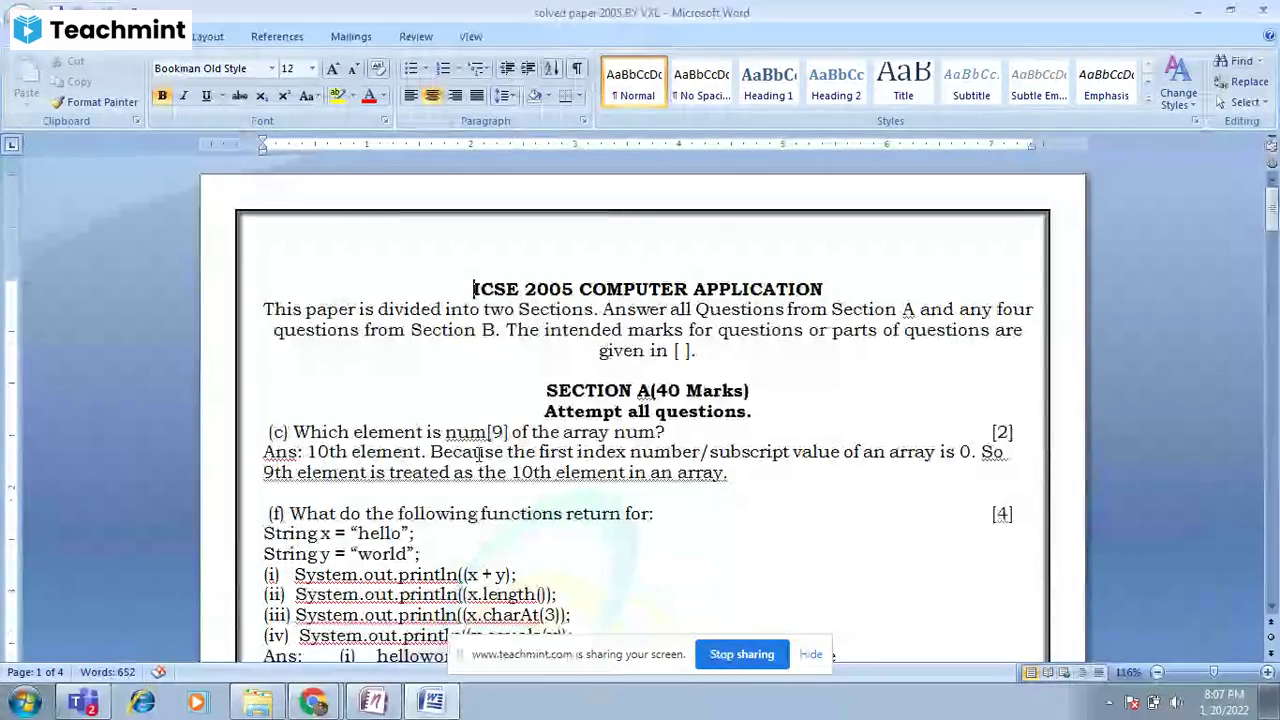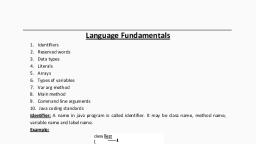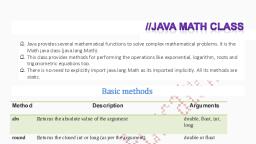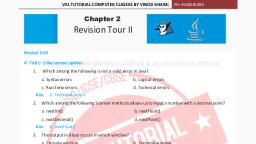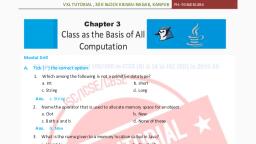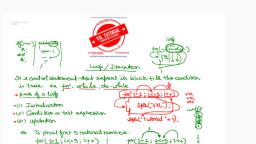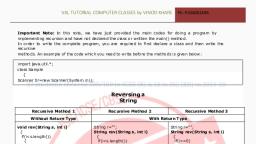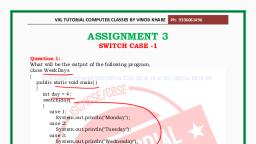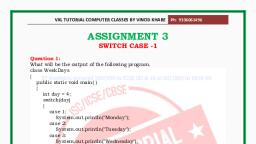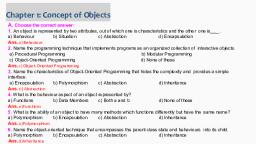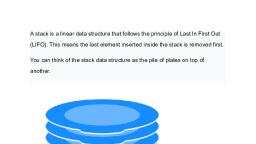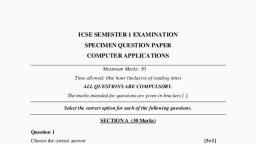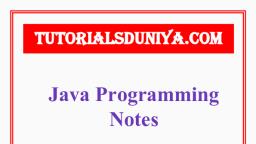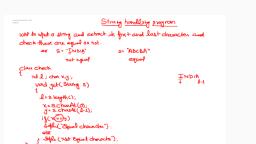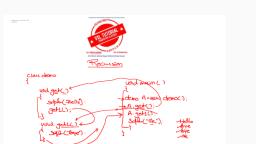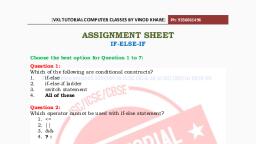Page 1 :
VXL TUTORIAL by VINOD KHARAY PH: 9336061496, , Chapter 4, , User-Defined Methods, Mental Drill, A., , Tick (√ ) the correct option., 1., , Once a function is defined, it can be invoked repeatedly. What is this feature called?, a. Interface, , b. Reusability, , c. Restructuring, Ans. b. Reusability, 2., , d. All of these, , If a function does not return any value, its return type should be:, a. int, , b. no-return, , c. void, Ans. c. void, 3., , d. empty, , A function that computes a value and returned is called:, a. Computational function, , c. Procedural function, Ans. a. Computational function, 4., , b. Actual parameter, , c. Both a and b, Ans. a. Formal parameter, , b. Function signature, , c. Both a and b, Ans. b. Function signature, a. Function prototype, , b. Function signature, , c. Both a and b, , d. None of these, , a. Function prototype, , The number of values that a function can return is:, a. 1, , Ans., 125, , d. None of these, , The first line of the function definition is called:, , Ans., 7., , d. None of these, , The parameter list in a function definition is called:, a. Function prototype, , 6., , d. None of these, , A type of parameter that are used to identify what data is to be passed to a function is called:, a. Formal parameter, , 5., , b. Manipulative function, , b. 2, , c. 3, , d. 4, , a. 1, User-Defined Methods
Page 2 :
VXL TUTORIAL by VINOD KHARAY PH: 9336061496, , 8., , A local variable in a function has its scope:, a. Limited within the function, b. Can be accessed anywhere within the same class, c. No limitation at all, d. None of these, , Ans., , a. Limited within the function, , 9. Which among the following is a valid name for a function?, a. function, , b. 2function, , c. fun in action, , d. fun#, , Ans., , a. function, , 10. Which among the following is not a valid access specifier?, a. public, , b. private, , c. partially, , d. protected, , Ans., B., , c. partially, , Fill in the blanks., 1., , In Java functions are known as methods., , 2., , Methods are contained in class., , 3., , The function name and the parameter list together is known as function signature., , 4., , The access specifier, return type and the function signature together is known as prototype., , 5., , The arguments of the function given in function prototype are called formal arguments., , 6., , The arguments of the function given in statement that calls the function are called actual, arguments., , 7., , If a function does not return any value, the returning type in the function prototype will be void., , 8., , When a function is called by value, the values of actual parameters are copied into separate, memory locations as allocated by the formal parameters., , 9., , Impure functions uses call by reference., , 10. One of the practical implementation of polymorphism is overloading., , SECTION A, A., , Answer the following questions., 1., , What is a method?, , Ans. A Java method is a collection of statements that are grouped together to perform an operation., Computer Applications – X (ICSE Course) Answers, , 126
Page 3 :
VXL TUTORIAL by VINOD KHARAY PH: 9336061496, , 2., , Write two advantages of using functions in a program., , Ans. Reduces complexity and Reusability., 3., , Explain the function of the ‘return’ statement., , Ans. The ‘return’ statement is used to return a value from a method, before exiting from the function., 4., , If a function contains several return statements, how many of them will be executed?, , Ans. The first one., 5., , Name the keyword that causes the control to transfer back to the method call., , Ans. return, 6., , What is the role of the keyword ‘void’ in declaring functions?, , Ans. The void keyword ensures that a method do not return any value., 7., , Classify functions depending upon the value it returns., , Ans. Computational function, Procedural functions and Manipulative functions, 8., , Differentiate between Formal Parameter and Actual Parameter., , Ans. Difference:, Formal Parameters, , 9., , Actual Parameters, , Parameter list in the function prototype., , Parameter list in the function invocation., , They are only variables., , They may be both variables or constants., , State the difference between function prototype and function signature., , Ans. Function prototype is the first line of the function definition that consist of return type function, name and the parameter list. Function signature on the other hand only specifies the parameter, list., 10., , How are functions called? How does it return a value?, , Ans. Functions are called using the name of the function, they may be called using either:, • Call by Value, , • Call by reference, , The return statement is used to return a value from a function., 11., , State the difference between Call by Value and Call by Reference., , Ans., Difference between Call by Value and Call by Reference, Call by Value, , Call by Reference, , Using this technique a copy of the values in Using this technique a reference to the values, the actual parameter is made in the formal in the actual parameter is made by the formal, parameters., parameters., 127, , User-Defined Methods
Page 4 :
VXL TUTORIAL by VINOD KHARAY PH: 9336061496, , Any changes made to the formal parameters, is not reflected back in the actual, parameters., Usually primitive data type is used during, call by value., 12., , Any changes made to the formal parameters is, reflected back in the actual parameters., Usually arrays and objects are used during call, by reference., , How are the following passed?, (i) Primitive types, , (ii) Reference types, , Ans. (i) Call by value, (ii) Call by reference, 13., , Differentiate between pure and impure function., , Ans., Difference between Pure and Impure Functions, , 14., , Pure Functions, , Impure Functions, , Pure functions are such functions which do, not change the state of an object., It doesn’t have any side effects as the state, of the object is not changed, rather only, accessed., , Impure functions are such functions which, changes the state of an object., It does have side effects as the state of the, object is changed, and therefore one should be, careful using it., , Explain function overloading with an example., , Ans., Example of function overloading:, class Overload, {, static void num_calc(int num,char ch), {, if(ch==’s’), System.out.println(“Square:”+(num*num));, else, System.out.println(“Square:”+(num*num*num));, }, static void num_calc(int a,int b,char ch), {, if(ch==’p’), System.out.println(“Product:”+(a*b));, else, System.out.println(“Sum:”+(a+b));, }, static void num_calc(String s1,String s2), {, Computer Applications – X (ICSE Course) Answers, , 128
Page 5 :
VXL TUTORIAL by VINOD KHARAY PH: 9336061496, , if(s1.equalsIgnoreCase(s2)), System.out.println(“Equal”);, else, System.out.println(“Not Equal”);, }, }, 15., , Which OOP principle implements function overloading?, , Ans. Polymorphism, 16., , When there are multiple definitions with the same function name, what makes them different, from each other?, , Ans. Function signature, 17., , What are the different access specifiers available in Java?, , Ans. default, public, private and protected, 18., , What is the use of main() method?, , Ans. The main() method, in general, is from where a program execution begins in Core Java., 19., , How are static methods of one class called by methods in other classes?, , Ans. The function invocation should be preceded with the name of the class followed by the dot, operator., B., , Write function prototypes for the following:, 1., , Private access method sum which accepts three int type variables as parameters and return a, float type., , Ans. private float sum(int a,int b,int c), 2., , Default access method “length” which accepts a String type variable as parameter and returns, an int type., , Ans. int length(String s), 3., , Public access method “increment” which accepts an object of Myclass type as parameter and, does not return any value., , Ans. public void increment(Myclass ob), 4., , Protected access method largest which accepts a float type, int type and double type data as, parameters and have a byte type as return type., , Ans. protected byte largest(float a, int b, double c), 5., , Public access static method calculate which accepts a byte and int type data type as parameters, and return float type., , Ans. public static float calculate(byte b, int d), , 129, , User-Defined Methods
Page 6 :
VXL TUTORIAL by VINOD KHARAY PH: 9336061496, , 6., , Write the function prototype for the function “sum” that takes an integer variable (x) as its, argument and returns a value of float data type., , Ans. float sum(int x), 7., , Write the prototype of a function which takes in 2 integers and 1 String arguments and returns, a value which is either ‘true’ or false’., , Ans. boolean function(int a,int b,String c), C., , Answer as directed:, 1., , In the program given below:, class MyClass, {, static int x = 7;, int y = 2;, public static void main(String args[ ]), {, MyClass obj = new MyClass();, System.out.println(x);, obj.sampleMethod(5);, int a= 6;, System.out.println(a);, }, void sampleMethod(int n), {, System.out.println(n);, System.out.println(y);, }, }, State the name and value of the:, (i) method argument or argument variable., (ii) class variable., (iii) local variable., (iv) instance variable., Ans., (i) main() =String args[] value=none, sampleMethod=int n value=5, (ii) x value=7, (iii) a value=6, (iv) y value=2, , Computer Applications – X (ICSE Course) Answers, , 130
Page 7 :
VXL TUTORIAL by VINOD KHARAY PH: 9336061496, , SECTION B, Write programs for the following:, 1., , Create a method which accepts two int type variable a and b as parameter and evaluate the, following expression:, 4.52a b2, , Ans., , ab, , and return it., , class Sol1, {, static double method(int a,int b), {, double c;, c=(4.2*a+b*b)/(a-b);, return c;, }, }, 2., , Create a function which accepts an integer as parameter and return true if it is a prime number, otherwise return false. In the main() method input an integer and using the above method, check whether it is a prime number or not., , Ans., import java.util.*;, class Sol2, {, static boolean isPrime(int n), {, int i,c=0;, for(i=1;i<=n;i++), {, if(n%i==0), c++;, }, if(c==2), return true;, else, return false;, }, static void main(), {, Scanner sc=new Scanner(System.in);, 131, , User-Defined Methods
Page 8 :
VXL TUTORIAL by VINOD KHARAY PH: 9336061496, , int n;, System.out.println(“Enter a number:”);, n=sc.nextInt();, if(isPrime(n)==true), System.out.println(“Prime Number”);, else, System.out.println(“Not a Prime Number”);, }, }, 3., , Create a function which accepts an integer as parameter and return true if it is a perfect, number otherwise return false. In the main() method input two integers and check whether, both the numbers are perfect numbers or not., , Ans., import java.util.*;, class Sol3, {, static boolean isPerfect(int n), {, int i,s=0;, for(i=1;i<n;i++), {, if(n%i==0), s+=i;, }, if(s==n), return true;, else, return false;, }, static void main(), {, Scanner sc=new Scanner(System.in);, int a,b;, System.out.println(“Enter 2 numbers:”);, a=sc.nextInt();, b=sc.nextInt();, if(isPerfect(a)==true && isPerfect(b)==true), System.out.println(“Both are prefect numbers”);, else, System.out.println(“Both are not perfect numbers”);, }, }, Computer Applications – X (ICSE Course) Answers, , 132
Page 9 :
VXL TUTORIAL by VINOD KHARAY PH: 9336061496, , 4., , Create a function which accepts an integer as parameter and return the sum of the square of, its digits. In the main() method display all three digit Armstrong numbers., , Ans., class Sol4, {, static int sum(int n), {, int i,s=0,d;, for(i=n;i>0;i=i/10), {, d=i%10;, s+=d*d*d;, }, return s;, }, static void main(), {, int i;, for(i=100;i<=999;i++), {, if(sum(i)==i), System.out.println(i);, }, }, }, 5., , Create a function which accepts an integer as parameter and return true if it is a palindrome, number or not. In the main() method input 10 integers and print the largest palindrome, number if any., , Ans., import java.util.*;, class Sol5, {, static boolean isPal(int n), {, int i,r=0,d;, for(i=n;i>0;i=i/10), {, d=i%10;, r=r*10+d;, }, if(r==n), return true;, 133, , User-Defined Methods
Page 10 :
VXL TUTORIAL by VINOD KHARAY PH: 9336061496, , else, return false;, }, static void main(), {, Scanner sc=new Scanner(System.in);, int i,max=0,n;, System.out.println(“Enter 10 numbers:”);, for(i=1;i<=10;i++), {, n=sc.nextInt();, if(isPal(n)==true), {, if(max==0), max=n;, if(n>max), max=n;, }, }, if(max>0), System.out.println(“Largest Palindrome Number:”+max);, else, System.out.println(“No palindrome number present”);, }, }, 6., , Create a function which accepts an integer as parameter and return the sum of its digits., Create another function to input 10 integers and find the sum of the digits of each number., , Ans., import java.util.*;, class Sol6, {, static int sum(int n), {, int i,s=0,d;, for(i=n;i>0;i=i/10), {, d=i%10;, s=s+d;, }, return s;, }, static void main(), {, Computer Applications – X (ICSE Course) Answers, , 134
Page 11 :
VXL TUTORIAL by VINOD KHARAY PH: 9336061496, , Scanner sc=new Scanner(System.in);, int i,s,n;, System.out.println(“Enter 10 numbers:”);, for(i=1;i<=10;i++), {, n=sc.nextInt();, s=sum(n);, System.out.println(“Sum of the digits of”+n+“is”+s);, }, }, }, 7., , Create a function which accepts an integer as parameter and return the largest digit. Create, another function to input 10 integers and find the sum of the largest digit of each number., , Ans., import java.util.*;, class Sol7, {, static int largest(int n), {, int i,max=0,d;, for(i=n;i>0;i=i/10), {, d=i%10;, if(d>max), max=d;, }, return max;, }, static void main(), {, Scanner sc=new Scanner(System.in);, int i,s=0,n,max;, System.out.println(“Enter 10 numbers:”);, for(i=1;i<=10;i++), {, n=sc.nextInt();, max=largest(n);, s+=max;, }, System.out.println(“Sum =”+s);, }, }, 135, , User-Defined Methods
Page 12 :
VXL TUTORIAL by VINOD KHARAY PH: 9336061496, , 8., , Create a method which accepts temperature in Celsius and return its Fahrenheit equivalent., Create another method which accepts temperature in Fahrenheit and return its Celsius, equivalent. Also create a method to invoke the above methods., , Ans., import java.util.*;, class Sol8, {, static double CelToFar(double C), {, double F=9*C/5+32;, return F;, }, static double FarToCel(double F), {, double C=(F-32)*5/9;, return C;, }, static void main(), {, Scanner sc=new Scanner(System.in);, double C,F;, System.out.println(“Enter temperature in Celcius:”);, C=sc.nextDouble();, F=CelToFar(C);, System.out.println(“Temperature in Farenheit:”+F);, System.out.println(“Enter temperature in Farenheit:”);, F=sc.nextDouble();, C=FarToCel(F);, System.out.println(“Temperature in Celcius:”+C);, }, }, 9., , Create a class with the following methods:, a. int sum(int n), which finds the sum of the digits in n and returns it., b. void call() to input an integer using scanner and find the sum of its digits using the above, method., , Ans., import java.util.*;, class Sol9, {, static int sum(int n), {, int i,d,s=0;, for(i=n;i>0;i=i/10), Computer Applications – X (ICSE Course) Answers, , 136
Page 13 :
VXL TUTORIAL by VINOD KHARAY PH: 9336061496, , {, d=i%10;, s+=d;, }, return s;, }, static void call(), {, Scanner sc=new Scanner(System.in);, int n,s;, System.out.println(“Enter a number:”);, n=sc.nextInt();, s=sum(n);, System.out.println(“Sum:”+s);, }, }, 10., , Create a class with the following methods:, a. int sum(int n), which finds the sum of the digits in n and returns it., b. void call() to input 10 integers using scanner and find the sum of its digits of each integer, value entered by the user using the above method., , Ans., import java.util.*;, class Sol10, {, static int sum(int n), {, int i,d,s=0;, for(i=n;i>0;i=i/10), {, d=i%10;, s+=d;, }, return s;, }, static void call(), {, Scanner sc=new Scanner(System.in);, int n,s,i;, System.out.println(“Enter 10 numbers:”);, for(i=1;i<=10;i++), {, n=sc.nextInt();, 137, , User-Defined Methods
Page 14 :
VXL TUTORIAL by VINOD KHARAY PH: 9336061496, , s=sum(n);, System.out.println(“Sum of the digits in:”+n+ “is”+s);, }, }, }, 11., , Create a class with the following methods:, a. boolean prime(int n), which returns true if n is prime otherwise returns false., b. void call() to input 10 integers using scanner and find the sum of those integers which are, prime numbers using the above method., , Ans., import java.util.*;, class Sol11, {, static boolean prime(int n), {, int i,c=0;, for(i=1;i<=n;i++), {, if(n%i==0), c++;, }, if(c==2), return true;, else, return false;, }, static void call(), {, Scanner sc=new Scanner(System.in);, int n,i,s=0;, System.out.println(“Enter 10 numbers:”);, for(i=1;i<=10;i++), {, n=sc.nextInt();, if(prime(n)==true), s+=n;, }, System.out.println(“Sum of Prime Numbers:”+s);, }, }, Computer Applications – X (ICSE Course) Answers, , 138
Page 15 :
VXL TUTORIAL by VINOD KHARAY PH: 9336061496, , 12., , Create a class with the following methods:, a. boolean is Armstrong(int n), which returns true if n is Armstrong number otherwise, returns false., Armstrong numbers are those numbers, whose sum of the cube of its digits is equal to, the number., Eg. 153 = 13 + 53 + 33, b. void call() to input 10 integers using scanner and find largest Armstrong number if any., , Ans., import java.util.*;, class Sol12, {, static boolean isArmstrong(int n), {, int i,s=0,d;, for(i=n;i>0;i=i/10), {, d=i%10;, s+=d*d*d;, }, if(s==n), return true;, else, return false;, }, static void call(), {, Scanner sc=new Scanner(System.in);, int i,n,max=0;, System.out.println(“Enter 10 numbers:”);, for(i=1;i<=10;i++), {, n=sc.nextInt();, if(isArmstrong(i)==true), {, if(max==0), max=n;, if(n>max), max=n;, }, }, if(max>0), System.out.println(“Largest armstrong number:”+max);, else, 139, , User-Defined Methods
Page 16 :
VXL TUTORIAL by VINOD KHARAY PH: 9336061496, , System.out.println(“No armstrong number present”);, }, }, 13., , Create a class with the following methods:, a. boolean prime(int n), which returns true if n is prime otherwise returns false., b. void call() to input 2 integers using scanner and print only the prime numbers between, the given integers., , Ans., import java.util.*;, class Sol13, {, static boolean prime(int n), {, int i,c=0;, for(i=1;i<=n;i++), {, if(n%i==0), c++;, }, if(c==2), return true;, else, return false;, }, static void call(), {, Scanner sc=new Scanner(System.in);, int i,a,b,s,l;, System.out.println(“Enter 2 numbers:”);, a=sc.nextInt();, b=sc.nextInt();, if(a>b), {, l=a;, s=b;, }, else, {, l=b;, s=a;, }, for(i=s+1;i<l;i++), {, Computer Applications – X (ICSE Course) Answers, , 140
Page 17 :
VXL TUTORIAL by VINOD KHARAY PH: 9336061496, , if(prime(i)==true), System.out.println(“Prime number:”+i);, }, }, }, 14., , Create a class with the following methods:, a. boolean prime(int n), which returns true if n is prime otherwise returns false., b. int sum(int n), which finds the sum of the digits in n and returns it., c. void call() to display all such three digit numbers, whose sum of the digits is a prime number., , Ans., class Sol14, {, static boolean prime(int n), {, int i,c=0;, for(i=1;i<=n;i++), {, if(n%i==0), c++;, }, if(c==2), return true;, else, return false;, }, static int sum(int n), {, int i,d,s=0;, for(i=n;i>0;i=i/10), {, d=i%10;, s+=d;, }, return s;, }, static void call(), {, int i,s;, for(i=100;i<=999;i++), {, s=sum(i);, if(prime(s)==true), System.out.println(“Prime number:”+i);, }, }, }, 141, , User-Defined Methods
Page 18 :
VXL TUTORIAL by VINOD KHARAY PH: 9336061496, , 15., , Create a class with the following methods:, a. boolean prime(int n), which returns true if n is prime otherwise returns false., b. boolean palindrome(int n), which returns true if n is palindrome otherwise returns false., c. void call() to display all three digit pal-prime numbers. Pal-prime numbers are those, numbers which are both palindrome as well as prime., , Ans., class Sol15, {, static boolean prime(int n), {, int i,c=0;, for(i=1;i<=n;i++), {, if(n%i==0), c++;, }, if(c==2), return true;, else, return false;, }, static boolean palindrome(int n), {, int i,r=0,d;, for(i=n;i>0;i=i/10), {, d=i%10;, r=r*10+d;, }, if(r==n), return true;, else, return false;, }, static void call(), {, int i,s;, for(i=100;i<=999;i++), {, if(prime(i)==true && palindrome(i)==true), System.out.println(“Pal-Prime number:”+i);, }, }, }, Computer Applications – X (ICSE Course) Answers, , 142
Page 19 :
VXL TUTORIAL by VINOD KHARAY PH: 9336061496, , 16., , Create a class with the following methods:, a. boolean prime(int n), which returns true if n is prime otherwise returns false., b. void call() to display all two digit twin-prime numbers. Twin-prime numbers are those, pair of numbers which are both prime as well as whose difference is 2. For example, 11, and 13, 17 and 19, etc., , Ans., class Sol16, {, static boolean prime(int n), {, int i,c=0;, for(i=1;i<=n;i++), {, if(n%i==0), c++;, }, if(c==2), return true;, else, return false;, }, static void call(), {, int i,s;, for(i=10;i<=98;i++), {, if(prime(i)==true && prime(i+2)==true), System.out.println(“Twin-Prime number:”+i+“ ”+(i+2));, }, }, }, 17., , Create a class with the following methods:, a. boolean prime(int n), which returns true if n is prime otherwise returns false., b. int sumPrime(int n), which returns the sum of prime digits present in integer n., c. void call() to input an integer and check whether the sum of prime digits is also a prime, number or not., , Ans., import java.util.*;, class Sol17, {, static boolean prime(int n), {, 143, , User-Defined Methods
Page 20 :
VXL TUTORIAL by VINOD KHARAY PH: 9336061496, , int i,c=0;, for(i=1;i<=n;i++), {, if(n%i==0), c++;, }, if(c==2), return true;, else, return false;, }, static int sumPrime(int n), {, int i,s=0,d;, for(i=n;i>0;i=i/10), {, d=i%10;, if(prime(d)==true), s=s+d;, }, return s;, }, static void call(), {, int i,s,n;, Scanner sc=new Scanner(System.in);, System.out.println(“Enter a number:”);, n=sc.nextInt();, s=sumPrime(n);, if(prime(s)==true), System.out.println(“Sum of the prime digits is also a prime number”);, else, System.out.println(“Sum of the prime digits is not a prime number”);, }, }, 18., , Create a class with the following methods:, a. int largest(int a,int b), which returns largest among the two integers a and b and return, it., b. void call() to input 10 integers and using the above function find the largest among the, 10 integers., , Ans., import java.util.*;, class Sol18, {, Computer Applications – X (ICSE Course) Answers, , 144
Page 21 :
VXL TUTORIAL by VINOD KHARAY PH: 9336061496, , static int largest(int a,int b), {, if(a>b), return a;, else, return b;, }, static void call(), {, int i,max=0,n;, Scanner sc=new Scanner(System.in);, System.out.println(“Enter 10 numbers:”);, for(i=1;i<=10;i++), {, n=sc.nextInt();, if(max==0), max=n;, else, max=largest(max,n);, }, System.out.println(“Largest:”+max);, }, }, 19., , Create a class with the following methods:, a. int LCM(int a,int b), which returns the least common multiple(LCM) among the two, integers a and b and return it., b. void call() to input 10 integers and using the above function find the LCM among the 10, intgers., , Ans., import java.util.*;, class Sol19, {, static int LCM(int a,int b), {, int i;, for(i=a;i<=a*b;i++), {, if(i%a==0 && i%b==0), break;, }, return i;, }, 145, , User-Defined Methods
Page 22 :
VXL TUTORIAL by VINOD KHARAY PH: 9336061496, , static void call(), {, int i,lcm=0,n;, Scanner sc=new Scanner(System.in);, System.out.println(“Enter 10 numbers:”);, for(i=1;i<=10;i++), {, n=sc.nextInt();, if(lcm==0), lcm=n;, else, lcm=LCM(lcm,n);, }, System.out.println(“Largest:”+lcm);, }, }, 20., , Create a class with the following methods:, a. int HCF(int a,int b), which returns the highest common factor(HCF) among the two, integers a and b and return it., b. void call() to input 10 integers and using the above function find the HCF among the 10, intgers., Ans. import java.util.*;, class Sol20, {, static int HCF(int a,int b), {, int i;, for(i=a;i<=a*b;i++), {, if(i%a==0 && i%b==0), break;, }, return (a*b)/i;, }, static void call(), {, int i,hcf=0,n;, Scanner sc=new Scanner(System.in);, System.out.println(“Enter 10 numbers:”);, for(i=1;i<=10;i++), {, n=sc.nextInt();, Computer Applications – X (ICSE Course) Answers, , 146
Page 23 :
VXL TUTORIAL by VINOD KHARAY PH: 9336061496, , if(hcf==0), hcf=n;, else, hcf=HCF(hcf,n);, }, System.out.println(“Largest:”+hcf);, }, }, 21., , Create a class called GeneratePrime which will be used to generate n number of prime, numbers. The class should have the following methods:, (i) Method called isPrime() which accepts an integer as a parameter and return true if it is a, prime number otherwise return false., (ii) Method called display() which accepts an integer n as Scanner input and display the first, n prime number by calling the above function., , Ans., import java.util.*;, class GeneratePrime, {, static boolean isPrime(int n), {, int i,c=0;, for(i=1;i<=n;i++), {, if(n%i==0), c++;, }, if(c==2), return true;, else, return false;, }, static void display(), {, int i=0,n,p=2;, Scanner sc=new Scanner(System.in);, System.out.println(“Enter a number:”);, n=sc.nextInt();, while(i<n), {, if(isPrime(p)==true), {, System.out.println(p);, i++;, 147, , User-Defined Methods
Page 24 :
VXL TUTORIAL by VINOD KHARAY PH: 9336061496, , }, p++;, }, }, }, 22., , Create a class with the following Member Functions:, (i) Method called isPrime() which accepts an integer as a parameter and return true if it is a, prime number otherwise return false., (ii) Method called sumOfPrimeDigits() which accepts an integer as a parameter and return, the sum of prime digits only., (iii) Method called check() which accepts 10 integers and checks whether the sum of the, prime numbers is also a prime number or not., Ans. import java.util.*;, class Sol22, {, static boolean isPrime(int n), {, int i,c=0;, for(i=1;i<=n;i++), {, if(n%i==0), c++;, }, if(c==2), return true;, else, return false;, }, static int sumOfPrimeDigits(int n), {, int i,s=0,d;, for(i=n;i>0;i=i/10), {, d=i%10;, if(isPrime(d)==true), s=s+d;, }, return s;, }, static void check(), {, int i,s=0,n;, Scanner sc=new Scanner(System.in);, Computer Applications – X (ICSE Course) Answers, , 148
Page 25 :
VXL TUTORIAL by VINOD KHARAY PH: 9336061496, , System.out.println(“Enter 10 numbers:”);, for(i=1;i<=10;i++), {, n=sc.nextInt();, if(isPrime(n)==true), s+=n;, }, if(isPrime(s)==true), System.out.println(“Sum of the prime numbers is also a prime number”);, else, System.out.println(“Sum of the prime numbers is not a prime number”);, }, }, 23., , Create a class called Series which will contain the following members function:, (i) long fact(int f) to find the factorial of f and return it., (ii) void sumSeries1(int x,int n) to calculate and print the sum of the following series:, x+x/2!+x/3!+x/4!+...+x/n!, (iii) void sumSeries2(int x,int n) to calculate and print the sum of the following series:, x/2!+x2/3!+x3/4!+x4/5!+… +xn/(n+1)!, (iv) void sumSeries3(int x,int n) to calculate and print the sum of the following series: x/2! x2/3!+x3/4! -x4/5!+…±xn/(n+1)!, Where the symbol ! stands for factorial eg. 5!=5*4*3*2*1, 3!=3*2*1, , Ans., class Series, {, static long fact(int f), {, long i,p=1;, for(i=1;i<=f;i++), {, p=p*i;, }, return p;, }, static void sumSeries1(int x,int n), {, double s=0;, int i;, for(i=1;i<=n;i++), {, s=s+(double)x/fact(i);, }, System.out.println(“Sum=”+s);, }, 149, , User-Defined Methods
Page 26 :
VXL TUTORIAL by VINOD KHARAY PH: 9336061496, , static void sumSeries2(int x,int n), {, double s=0;, int i;, for(i=1;i<=n;i++), {, s=s+Math.pow(x,i)/fact(i+1);, }, System.out.println(“Sum=”+s);, }, static void sumSeries3(int x,int n), {, double s=0;, int i;, for(i=1;i<=n;i++), {, if(i%2==0), s=s-Math.pow(x,i)/fact(i+1);, else, s=s+Math.pow(x,i)/fact(i+1);, }, System.out.println(“Sum=”+s);, }, }, 24., , Using overloading technique, write methods to:, • accept two int type data as parameters and return their sum., • accept three int type data as parameters and return their sum., • accept two double type data as parameter and return their sum., • accept a double type and int type as parameter and return their sum., , Ans., import java.util.*;, class Sol24, {, static int overload(int a,int b), {, int s;, s=a+b;, return s;, }, static int overload(int a,int b,int c), {, int s;, s=a+b+c;, return s;, Computer Applications – X (ICSE Course) Answers, , 150
Page 27 :
}, static double overload(double a,double b), {, double s;, s=a+b;, return s;, }, static double overload(double a,double b,double c), {, double s;, s=a+b+c;, return s;, }, }, 25., , Create a function which accepts an integer as parameter and return true if it is a prime number, otherwise return false. Create another function which accepts an integer as parameter and, return true if it is palindrome otherwise return false. In the main() method display all three, digit pal-prime number. Palprime numbers are such numbers which are both palindrome as, well as prime numbers.For example, 101,131,151,181,191,313,353,373,383,727,757,787,797,, 919 and 929 are all three digit pal-prime numbers., , Ans., import java.util.*;, class Sol25, {, static boolean prime(int n), {, int i,c=0;, for(i=1;i<=n;i++), {, if(n%i==0), c++;, }, if(c==2), return true;, else, return false;, }, static boolean palindrome(int n), {, int i,r=0,d;, for(i=n;i>0;i=i/10), {, d=i%10;, r=r*10+d;, 151, , User-Defined Methods
Page 28 :
}, if(r==n), return true;, else, return false;, }, static void main(), {, int i,s;, for(i=100;i<=999;i++), {, if(prime(i)==true && palindrome(i)==true), System.out.println(“Pal-Prime number:”+i);, }, }, }, 26., , Create a function which accepts an integer as parameter and return the sum of its digits., Create another function which accepts an integer as parameter and return true if it is magic, number otherwise return false. In the main input an integer and check whether it is a magic, number or not., If you iterate the process of summing the decimal digits of a number and if this process, terminates in 1, then the original number is called a magic number. For example 55=>, (5+5)=10=>(1+0)=1., , Ans., import java.util.*;, class Sol26, {, static int sum(int a), {, int i,d,s=0;, for(i=a;i>0;i=i/10), {, d=i%10;, s=s+d;, }, return s;, }, static boolean isMagic(int n), {, do, {, n=sum(n);, Computer Applications – X (ICSE Course) Answers, , 152
Page 29 :
}while(n>9);, if(n==1), return true;, else, return false;, }, static void main(), {, int n;, Scanner sc=new Scanner(System.in);, System.out.println(“Enter a number:”);, n=sc.nextInt();, if(isMagic(n)==true), System.out.println(“Magic Number”);, else, System.out.println(“Not a Magic Number”);, }, }, 27., , Create a function which accepts an integer as parameter and return the sum of the square of, its digits. Create another function which accepts an integer as parameter and return true if it, is happy number otherwise return false. In the main input an integer and check whether it is, a happy number or not.. For example 7=> (72)=49=> (42+92)=97=>(92 +72)=130 =>(12 +32+02)=10, =>(12+02)= 1., , Ans., import java.util.*;, class Sol27, {, static int sum(int a), {, int i,d,s=0;, for(i=a;i>0;i=i/10), {, d=i%10;, s=s+d*d;, }, return s;, }, static boolean isHappy(int n), {, do, {, n=sum(n);, }while(n>9);, 153, , User-Defined Methods
Page 30 :
if(n==1), return true;, else, return false;, }, static void main(), {, int n;, Scanner sc=new Scanner(System.in);, System.out.println(“Enter a number:”);, n=sc.nextInt();, if(isHappy(n)==true), System.out.println(“Happy Number”);, else, System.out.println(“Not a Happy Number”);, }, }, 28., , Create a class with the following functions:, (i) boolean isBinary() which accepts a binary number as parameter and return true if it is a, valid binary number or not. A binary number consists of only two digits 0 and 1., (ii) int binToDecimal(int b) which accepts a binary number as parameter and return its, decimal equivalent., (iii) int deciToBinary(int d) which accepts a decimal number as parameter and return its, binary equivalent., (iv) void sum() where you input two binary numbers and if they are valid binary numbers, find their sum., Sample input and output when the sum() function is executed:, INPUT, Enter two valid binary numbers: 1011 11011, OUTPUT, Sum of the two given binary numbers is: 100110, , Ans., import java.util.*;, class Sol28, {, static boolean isBinary(int b), {, int i,d,f=0;, for(i=b;i>0;i=i/10), {, d=i%10;, if(!(d==1 ||d==0)), f=1;, }, Computer Applications – X (ICSE Course) Answers, , 154
Page 31 :
if(f==0), return true;, else, return false;, }, static int binToDecimal(int b), {, int i,d,s=0,c=0;, for(i=b;i>0;i=i/10), {, d=i%10;, s=s+d*(int)Math.pow(2,c++);, }, return s;, }, static int decToBinary(int d), {, int i,r,s=0,c=0;, for(i=d;i>0;i=i/2), {, r=i%2;, s=s+r*(int)Math.pow(10,c++);, }, return s;, }, static void sum(), {, int a,b,s;, Scanner sc=new Scanner(System.in);, System.out.println(“Enter 2 valid binary numbers:”);, a=sc.nextInt();, b=sc.nextInt();, if (isBinary(a)==false || isBinary(b)==false), System.out.println(“Both should be valid binary numbers”);, else, {, s=binToDecimal(a)+binToDecimal(b);, s=decToBinary(s);, System.out.println(“Sum of the 2 given binary number is:”+s);, }, }, }, 155, , User-Defined Methods
Page 32 :
29., , Write a class with the name volume using function overloading that computes the volume of, a cube, a sphere and a cuboid., Formula:, volume of a cube (vc) = s*s*s, volume of a sphere (vs) = 4/3 * pi * r * r * r (where pi = 3.14 or 22/7), Volume of a cuboid (vcd) = l * b * h, , Ans., class volume, {, static void overload(int s)//cube, {, int vc;, vc=s*s;, System.out.println(“Volume of the cube:”+vc);, }, static void overload(float r)//sphere, {, float vs;, vs=4/3f*3.14f*r*r*r;, System.out.println(“Volume of the sphere:”+vs);, }, static void overload(int l,int b,int h)//cuboid, {, int vcd;, vcd=l*b*h;, System.out.println(“Volume of the cuboid:”+vcd);, }, }, 30., , Design a class to overload a function num_calc( ) as follows:, a. void num_calc(int num,char ch) with one integer argument and one character argument,, computes the square of integer argument if choice ch is ‘s’ otherwise find its cube., b. void num_calc(int a, int b,char ch) with two integer arguments if ch is ‘p’ else adds the, integers., c. void num_calc(String s1,String s2) with two String arguments, which prints whether the, strings are equal or not., , Ans., class Overload, {, static void num_calc(int num,char ch), {, if(ch==’s’), System.out.println(“Square:”+(num*num));, else, Computer Applications – X (ICSE Course) Answers, , 156
Page 33 :
System.out.println(“Cube:”+(num*num*num));, }, static void num_calc(int a,int b,char ch), {, if(ch==’p’), System.out.println(“Product:”+(a*b));, else, System.out.println(“Sum:”+(a+b));, }, static void num_calc(String s1,String s2), {, if(s1.equalsIgnoreCase(s2)), System.out.println(“Equal”);, else, System.out.println(“Not Equal”);, }, }, 31., , Design a class to overload a function compare() as follows:, a. void compare(int,int) - to compare two integer values and print the greater of the two, integers., b. void compare(char,char) - to compare the numeric values of two characters and print the, character with higher numeric value., c. void compare(String, String) - to compare the length of the two strings and print the, longer of the two., , Ans., class Sol31, {, static void compare(int a,int b), {, if(a>b), System.out.println(a);, else, System.out.println(b);, }, static void compare(char a,char b), {, if((int)a>(int)b), System.out.println(a);, else, System.out.println(b);, }, static void compare(String s1,String s2), {, if(s1.length()>s2.length()), 157, , User-Defined Methods
Page 34 :
System.out.println(“First string is greater”);, else, System.out.println(“second string is greater”);, }, }, 32., , Design a class to overload a function polygon() as follows:, (i) void polygon(int n, char ch): with one integer argument and one character type argument, that draws a filled square of side n using the character stored in ch., (ii) void polygon(int x, int y): with two integer arguments that draws a filled rectangle of, length x and breadth y, using the symbol ‘@’, (iii) void polygon(): with no argument that draws a filled triangle shown below:, *, **, ***, , Ans., class Sol32, {, static void polygon(int n,char ch), {, int i,j;, for(i=1;i<=n;i++), {, for(j=1;j<=n;j++), {, System.out.print(ch);, }, System.out.println();, }, }, static void polygon(int x,int y), {, int i,j;, for(i=1;i<=y;i++), {, for(j=1;j<=x;j++), {, System.out.print(“@”);, }, System.out.println();, }, }, static void polygon(), {, int i,j;, Computer Applications – X (ICSE Course) Answers, , 158
Page 35 :
for(i=1;i<=3;i++), {, for(j=1;j<=i;j++), {, System.out.print(“*”);, }, System.out.println();, }, }, }, 33., , Design a class to overload a function compute() as follows:, (i) void compute(int,char): to compute the square of the integer argument if the given, character argument is ‘s’ otherwise find its cube., (ii) void compute(double char): to compute voume of a cube if the given character argument, is ‘v’ otherwise find its diagonal., (iii) void compute(int,int,char): to compute area of a rectangle if the given character argument, is ‘a’ otherwise finds its perimeter., Volume of cube=side3, Area of rectangle=length*breadth, Diagonal of cube=a√3, Perimeter of rectangle=2*(length+breadth), , Ans., class Sol33, {, static void compute(int num,char ch), {, if(ch==’s’), System.out.println(“Square:”+(num*num));, else, System.out.println(“Cube:”+(num*num*num));, }, static void compute(double s,char ch), {, if(ch==’v’), System.out.println(“Volume:”+(s*s*s));, else, System.out.println(“Diagonal:”+(s*Math.sqrt(s)));, }, static void num_calc(int l,int b,char ch), {, if(ch==’a’), System.out.println(“Area:”+(l*b));, else, System.out.println(“Perimeter:”+(2*(l+b)));, }, }, 159, , User-Defined Methods
Page 36 :
34., , Design a class to overload a function series() as follows:, (i) double series(double n) with one double argument and returns the sum of the series., sum = 1/1 + 1/2 + 1/3 + ….. 1/n, (ii) double series(double a, double n) with two double arguments and returns the sum of the, series. sum, = 1/a2 + 4/a5 + 7/a8 + 10/a11 ….. to n terms, , Ans., class Sol34, {, static double series(double n), {, double s=0,i;, for(i=1;i<=n;i++), {, s+=1/i;, }, return s;, }, static double series(double a,double n), {, double s=0,i,c=1;, for(i=1;i<=n;i++), {, s+=c/Math.pow(a,c+1);, c+=3;, }, return s;, }, }, 35., , Design a class to overload a function series( ) as follows:, (i) double series(double n) with one double argument and returns the sum of the series:, S1, , 1, , , , 2!, , 1, , 1, 1, ..., 3! 4!, n!, , (ii) double series(double x,double n) with two double arguments and returns the sum of the, series, Sx, , x2, 2!, , , , x3, 3!, , , , x4, 4!, , ..., , xn, n!, , Ans., class Sol35, {, static double series(double n), Computer Applications – X (ICSE Course) Answers, , 160
Page 37 :
{, double s=0,i,j,f;, for(i=1;i<=n;i++), {, f=1;, for(j=1;i<=i;j++), {, f=f*j;, }, s+=1/f;, }, return s;, }, static double series(double x,double n), {, double s=0,i,j,f;, for(i=1;i<=n;i++), {, f=1;, for(j=1;i<=i;j++), {, f=f*j;, }, s+=Math.pow(x,i)/f;, }, return s;, }, }, 36., , Write a menu driven program to accept a number from the user and check whether is a ‘BUZZ’, number or to accept any two numbers and print ‘GCD’ of them., a. A BUZZ number is the number which either ends with 7 or divisible by 7., b. GCD (Greatest Common Divisor) of two integers is calculated by continued division, method. Divide the larger number by the smaller, the remainder then divides the previous, devisor. The process is repeated till the remainder is zero. The divisor then results the, GCD., , Ans., import java.util.*;, class Sol36, {, static void main(), {, Scanner sc=new Scanner(System.in);, int i,n,r,ch,d;, 161, , User-Defined Methods
Page 38 :
System.out.println(“M E N U”);, System.out.println(“1. Buzz Number”);, System.out.println(“2. GCD”);, System.out.println(“Enter your choice:”);, ch=sc.nextInt();, switch(ch), {, case 1:, System.out.println(“Enter a number:”);, n=sc.nextInt();, if(n%10==7 || n%7==0), System.out.println(“Buzz Number”);, else, System.out.println(“Not a Buxx number”);, break;, case 2:, System.out.println(“Enter 2 numbers:”);, n=sc.nextInt();, d=sc.nextInt();, do, {, r=n%d;, if(r!=0), {, n=d;, d=r;, }, }while(r!=0);, System.out.println(“GCD:”+d);, break;, default:, System.out.println(“Invalid choice!”);, }, }, }, 37., , Write a menu driven program to accept a number and check and display whether it is a Prime, Number or not OR an Automorphic Number or not. (Use switch-case statement)., a. Prime number: A number is said to be a prime number if it is divisible only by 1 and itself, and not by any other number. Example : 3,5,7,11,13, etc., b. Automorphic number: An automorphic number is the number which is contained in the, last digit(s) of its square. Example: 25 is an automorphic number as its square is 625 and, 25 is present as the last two digits., , Computer Applications – X (ICSE Course) Answers, , 162
Page 39 :
Ans., import java.util.*;, class Sol37, {, static boolean isPrime(int n), {, int i,c=0;, for(i=1;i<=n;i++), {, if(n%i==0), c++;, }, if(c==2), return true;, else, return false;, }, static boolean isAutomorphic(int n), {, int i,c=0;, for(i=n;i>0;i=i/10), {, c++;, }, if(n==(n*n)%(int)Math.pow(10,c)), return true;, else, return false;, }, static void main(), {, Scanner sc=new Scanner(System.in);, int i,n,r,ch,d;, System.out.println(“M E N U”);, System.out.println(“1. Prime Number”);, System.out.println(“2. Automorphic”);, System.out.println(“Enter your choice:”);, ch=sc.nextInt();, switch(ch), {, case 1:, 163, , User-Defined Methods
Page 40 :
System.out.println(“Enter a number:”);, n=sc.nextInt();, if(isPrime(n)==true), System.out.println(“Prime Number”);, else, System.out.println(“Not a prime number”);, break;, case 2:, System.out.println(“Enter a number:”);, n=sc.nextInt();, if(isAutomorphic(n)==true), System.out.println(“Automorphic Number”);, else, System.out.println(“Not an Automorphic number”);, break;, default:, System.out.println(“Invalid choice!”);, }, }, }, 38., , Write a menu driven program to perform the following: (Use switch case statement), a. To print the series 0,3,8,15,24… n terms(value of ‘n’ is to be an input by the user)., b. To find the sum of the series given below:, S= 1/2 + 3/4 + 5/6 + 7/8 …. 19/20., , Ans., import java.util.*;, class Sol38, {, static void series(int n), {, int i,s=0,c=3;, for(i=1;i<=n;i++), {, System.out.print(s+” “);, s=s+c;, c=c+2;, }, }, static void sumSeries(), {, Computer Applications – X (ICSE Course) Answers, , 164
Page 41 :
int i;, float s=0;, for(i=1;i<=19;i+=2), {, s+=(float)i/(i+1);, }, System.out.print(“Sum:”+s);, }, static void main(), {, Scanner sc=new Scanner(System.in);, int ch,n;, System.out.println(“M E N U”);, System.out.println(“1. Display series”);, System.out.println(“2. sum of the series”);, System.out.println(“Enter your choice:”);, ch=sc.nextInt();, switch(ch), {, case 1:, System.out.println(“Enter a number:”);, n=sc.nextInt();, series(n);, break;, case 2:, sumSeries();, break;, default:, System.out.println(“Invalid choice!”);, }, }, }, 39., , Using the switch statement, write a menu-driven program to:, (i) Generate and display the first 10 terms of the Fibonacci series 0,1,1,2,3,5,…., (ii) find the sum of the digits of an integer that is input. Eg 15390=18, For an incorrect choice, appropriate error message should be displayed., , Ans., import java.util.*;, class Sol39, {, 165, , User-Defined Methods
Page 42 :
static void fibo(), {, int i,f=1,s=0,t=0;, System.out.print(t+” “);, for(i=1;i<=9;i++), {, t=f+s;, System.out.print(t+” “);, f=s;, s=t;, }, }, static void sum(int n), {, int i,d,s=0;, for(i=n;i>0;i/=10), {, d=i%10;, s+=d;, }, System.out.print(“Sum:”+s);, }, static void main(), {, Scanner sc=new Scanner(System.in);, int ch,n;, System.out.println(“M E N U”);, System.out.println(“1. Fibonacci series”);, System.out.println(“2. Sum of the digits in a number”);, System.out.println(“Enter your choice:”);, ch=sc.nextInt();, switch(ch), {, case 1:, fibo();, break;, case 2:, System.out.println(“Enter a number:”);, n=sc.nextInt();, sum(n);, break;, Computer Applications – X (ICSE Course) Answers, , 166
Page 43 :
default:, System.out.println(“Invalid choice!”);, }, }, }, 40., , Using the switch statement, write a menu driven program:, (i) To check and display whether a number input by the user is a composite number or not, (A number is said to be a composite, if it has one or more then one factors excluding 1, and the number itself)., Example: 4, 6, 8, 9…, (ii) To find the smallest digit of an integer that is input:, Sample input: 6524, Sample output: Smallest digit is 2, For an incorrect choice, an appropriate error message should be displayed., , Ans., import java.util.*;, class Sol40, {, static void isComposite(int n), {, int i,c=0;, for(i=1;i<=n;i++), {, if(n%i==0), c++;, }, if(c>2), System.out.println(“Composite number”);, else, System.out.println(“Not a Composite number”);, }, static void smallest(int n), {, int i,d,min=0;, for(i=n;i>0;i=i/10), {, d=i%10;, if(min==0), min=d;, if(d<min), min=d;, }, System.out.println(“Smallest digit:”+min);, 167, , User-Defined Methods
Page 44 :
VXL TUTORIAL , 30 K BLOCK KIDWAI NAGAR, KANPUR PH: 9336061496, , }, static void main(), {, Scanner sc=new Scanner(System.in);, int i,n,r,ch,d;, System.out.println(“M E N U”);, System.out.println(“1. Composite Number”);, System.out.println(“2. Smallest digit in a number”);, System.out.println(“Enter your choice:”);, ch=sc.nextInt();, switch(ch), {, case 1:, System.out.println(“Enter a number:”);, n=sc.nextInt();, isComposite(n);, break;, case 2:, System.out.println(“Enter a number:”);, n=sc.nextInt();, smallest(n);, break;, default:, System.out.println(“Invalid choice!”);, }, }, }



